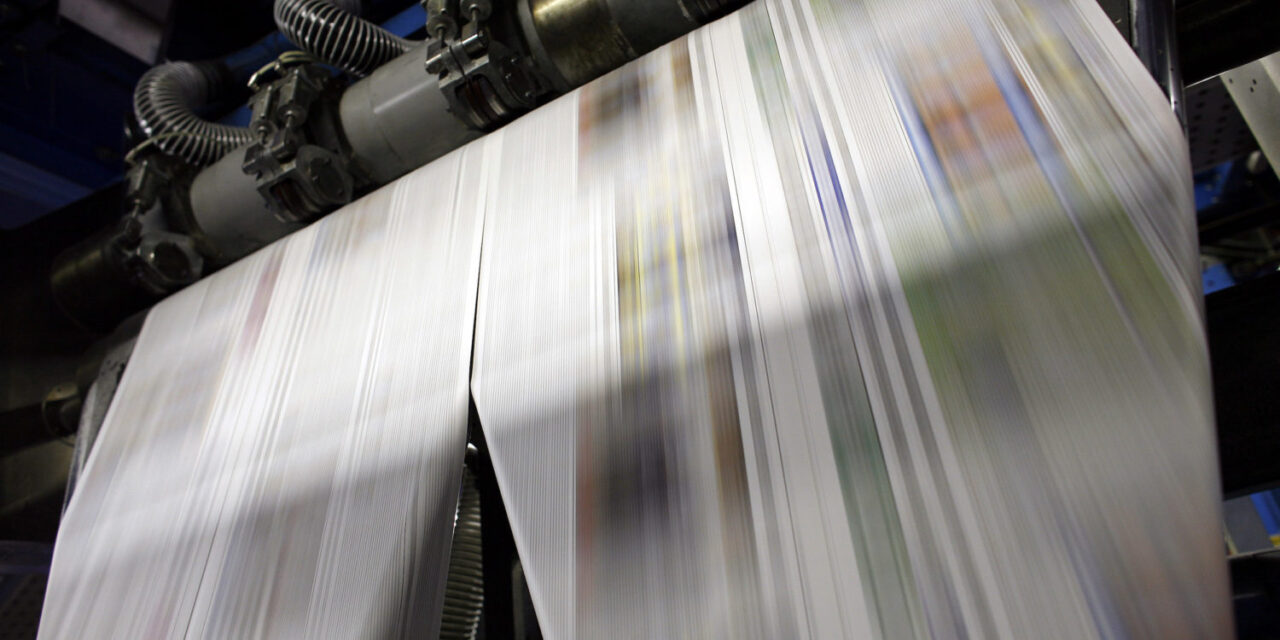Pictures and words shoot past in a blur at a newspaper printing plant. (AP Photo/Jason DeCrow)
By: Rick Edmonds
Source: www.poynter.org, October 2022
Inflation has been brutal in 2022 and looms as the potential deciding factor in next month’s midterm elections. Newspapers have had it even worse than voters. It has also been an off year for revenues in the hard-pressed sector, but expense increases have been truly terrible.
Surveying publishers at four independent regional outlets, I got these consensus figures:
- Newsprint up 30% or more.
- Other production supplies (ink, plates, etc.) up 10-15%.
- Electricity up 10-15%.
- Fuel up 50% or more, easing from peaks earlier in the year, but now in October, trending back up in some markets.
- Labor costs up, though harder to quantify because some positions, especially in delivery, are going unfilled.
Television stations and digital news outlets pay for electricity and rising staffing costs too, but the worst of this falls on newspapers, still stuck with print editions and the cost of getting them on customers’ doorsteps.
Digital transformation has been the mantra of the newspaper industry for several years now, but it looks less and less like a panacea.
In their latest newsletter on digital subscription strategy, go-to consultants Matt Lindsay and Peter Doucette of Mather Economics caution against trading out those print subscribers too quickly. The revenue return per print customer remains much higher than for a digital counterpart.
Plus the old revenue streams for print subscriptions and advertising remain too great to abandon.
Lindsay and Doucette suggest that some publishers should ease off the aggressive print subscription price increases that have become an industry norm, the better to retain those readers.
My sample was of strong independent papers – the Minneapolis Star Tribune, The Times-Picayune/The New Orleans Advocate, The Post and Courier of Charleston, S.C., and the Tampa Bay Times.
In general, they report that 2022 is not the year they had hoped for, but they are coping. None of them labors under a heavy debt load like Gannett’s that has forced two rounds of deep cuts over the last few months.
“With maintaining a comparatively large print base,” Minneapolis senior vice president and chief marketing officer Steve Yaeger emailed me, “some of the print-related expenses may be hitting Star Tribune more than some other publishers, but they are hard on all of us. … We are also seeing increases in some other areas. For example, we do quite a bit of direct mail and other print marketing, and paper costs are way up. Healthcare costs are also climbing.”
A saving grace, Yaeger said, is that the Star Tribune is having a relatively healthy advertising year.
Judi Terzotis, president of The Advocate and Times-Picayune, mentioned the cost of cyber security insurance as another rising cost. As for economizing, the strategy is a lot of comparatively little things like cutting back distribution of some free publications or bringing in-house some services like programmatic advertising that had been bought from vendors.
“We are still bullish on print,” Terzotis added. The 10-year-old New Orleans Advocate made its mark with a print edition, ultimately acquiring the rival Times-Picayune.
The Post and Courier is smaller than metros in major league markets (though not all that small with digital editions in other South Carolina cities). But the issues are much the same.
P.J. Browning, president of parent Evening Post’s newspaper division, said that she reluctantly imposed a fuel surcharge for print readers. “Without doing this,” she said, “we would have lost carriers, had more down routes, and really poor customer delivery service. This seemed palatable for our readers with hardly any pushback and helped us with minimal open routes.”
Managing newsprint also has demanded a balanced approach, Browning said. “We are mindful of our page counts, and while we don’t want to cut any news, we have run a little less national and international news and really focused on local. We also have increased home delivery rates. However, with our main goal of retaining readership in the long run, … we have decided to eat a lot of the expense in an effort to save readers.”
I also checked with Conan Gallaty, chairman and CEO of the Poynter-owned Tampa Bay Times. He noted that the Times, which shifted to a two-day-a-week print schedule in March 2020 and subsequently outsourced printing and sold its plant, is less exposed to newsprint and fuel/delivery costs than many papers.
But it’s not inconsequential. “Newsprint is astronomically high and remains in the stratosphere well beyond what we anticipated. This is despite reduced demand from us and every publisher we know. Consolidation has given remaining suppliers more leverage.”
The Times is deploying strategies like cutting back on free distribution volume and consolidating delivery routes where possible, he said. It doesn’t seem as if the elevated fuel and newsprint costs can last indefinitely, Gallaty added, but as the fall budgeting season begins, the Times is planning as if the higher prices will continue.
Time is running out on 2022, and it will go down as an especially challenging year for an industry in flux. A better 2023? That’s to be determined.


